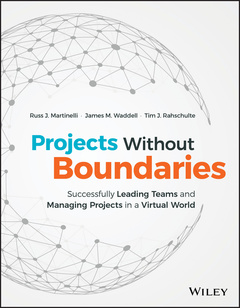Projects Without Boundaries Successfully Leading Teams and Managing Projects in a Virtual World
Auteurs : Martinelli Russ J., Waddell James M., Rahschulte Tim J.

Clear, proven solutions for virtual project management challenges
Projects Without Boundaries offers project managers a clear framework for bringing both project management practices and project team leadership principles to the virtual space. Written by a team of authors with years of experience managing nationally and internationally distributed teams, this book provides a suite of best practices, checklists, and actionable strategies for managing a project and building a high-performing team in a virtual and multicultural environment. Real-world examples illustrate the application of the concepts discussed, and the Virtual Project Readiness Assessment facilitates both team evaluation and transformation planning for virtual project management improvement. Each chapter focuses on the critical challenges encountered while managing virtual projects and details proven solutions that improve a virtual organization, boost project performance, and facilitate positive outcomes.
Globalization and technological advances have merged to create dynamic, productive teams that work together from around the globe; this opportunity can bring great difficulty for project managers, who must negotiate hurdles that do not exist on traditional projects. This book provides ready-made solutions specific to distributed and multicultural teams, to help you achieve the full potential of the global talent pool.
- Overcome common challenges of virtual projects with distributed teams
- Navigate complex team dynamics to ensure effective collaboration
- Work seamlessly across borders, time zones, and cultures
- Determine optimal virtual communication and collaboration tools
- Apply traditional project management practices in a virtual setting
A team fails or thrives on the strength of its management. Fitting the group's needs, expectations, personalities, and skills into a cohesive whole is seldom simple ? and distance adds an additional layer of complexity. Projects Without Boundaries provides expert guidance on keeping it together, with proven practices, tools, and virtual team leadership strategies.
Preface vii
Acknowledgments ix
I Introduction 1
1 Working in a Virtual World 3
Forces Driving Virtual Transformation 5
Rise of Virtual Organizations and Projects 9
Virtual Projects Are Different 10
Transitioning to the Virtual World 18
Assessing the Virtual Project Manager 19
Notes 22
II Planning the Virtual Project, Building the Virtual Team 23
2 Planning the Virtual Project 25
Planning a Virtual Project 26
Establishing Project Alignment 31
Architecting the Virtual Project 36
Understanding the Complexity of Virtual Projects 37
With Complexity Comes Risk 41
Planning Virtual Communication 43
Assessing Virtual Project Planning 45
Notes 48
3 Building a High-performance Virtual Team 49
Virtual Project Team Types 50
Differentiating High-Performance 55
Building a High-Performance Virtual Project Team 56
Assessing Virtual Project Team Members 68
Notes 69
III Managing Project Execution, Leading the Virtual Team 71
4 Executing the Virtual Project 73
Managing Assumptions 75
Hyper-vigilant Governance 76
Managing Outsourced Project Work 84
Managing Change 85
Integrating Distributed Work 87
People Side of Project Execution 89
Influencing Virtual Stakeholders 92
Assessing Virtual Project Execution 99
Notes 101
5 Leading the Virtual Project Team 103
Be the Project Compass 104
Be the Team Conductor 105
Be the Champion 106
Recognizing the Virtual Team 115
Leverage Your Leadership Style 117
Adding “E” to Leadership 119
Becoming an Effective Virtual Team Leader 120
Assessing Virtual Team Performance 120
Notes 122
6 Empowering the Project Network 125
Centralize First 125
Empowering by Decentralizing 133
Centralized/Decentralized Project Construct 148
Assessing Virtual Team Collaboration 149
Notes 151
IV Organizational Considerations 153
7 Leading a Multicultural Virtual Team 155
Putting Culture in Context 156
Cultural Intelligence 157
Challenges of Multicultural Virtual Project Teams 157
Cultural Factors 158
Creating a Cultural Strategy 165
Converging Company and Country Culture 169
Assessing Cross-Cultural Awareness 171
Notes 173
8 Using Technology to Communicate and Collaborate 175
Role of Technology 176
Using Technology to Communicate 176
Using Technology to Collaborate 179
Technology Options for the Virtual Project 180
No Shortage of Options 194
Technology Selection 194
Increasing Technology Usage 197
Notes 197
9 Sustaining Virtual Project Success 199
Changing Organizational and Team Structures 200
Modifying the Project Execution Model 203
Changing Behavior by Changing Rewards 205
Promoting Cultural Awareness 206
Developing Virtual Project Managers 208
Virtual Project Management Journey 219
Notes 219
Appendix Virtual Project Readiness Assessment 221
Index 227
RUSS J. MARTINELLI has managed virtual projects at Intel, Loral, and Lockheed Martin. He is the author of multiple books on program and project management, and provides training and consulting for both profit and non-profit companies.
JAMES M. WADDELL is an independent consultant who has held a variety of management positions in the high-tech and energy industries. He is also a co-founder of the Program Management Academy and the author of multiple program and project management books.
TIM J. RAHSCHULTE, PHD, is the chief learning officer at Evanta and professor of business at George Fox University. His experience has been in management consulting and venture funded new product development with the focus on leading organizational change and workforce development.
Date de parution : 04-2017
Ouvrage de 240 p.
20.1x24.1 cm
Mots-clés :
project management
